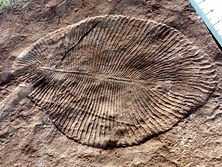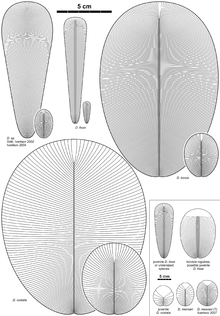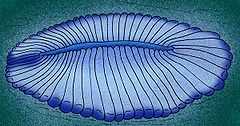Dickinsonia
| Dickinsonia Temporal range: Ediacaran, 560–555Ma | |
|---|---|
 | |
| Dickinsonia costata from Australia | |
| Scientific classification | |
| Kingdom: | Animalia |
| Phylum: | Proarticulata |
| Class: | Dipleurozoa[3] |
| Family: | Dickinsoniidae |
| Genus: | Dickinsonia Sprigg, 1947 |
| Species | |
|
See text | |
| Synonyms | |
Dickinsonia is an iconic fossil of the Ediacaran biota. It (roughly) resembles a bilaterally symmetrical ribbed oval. Its affinities are presently unknown; most interpretations consider it to be an animal, although others suggest it may be fungal, or a member of an "extinct kingdom".
Etymology
Dickinsonia was first described by Reg Sprigg, the original discoverer of the Ediacaran biota in Australia,[5] who named it after Ben Dickinson, then Director of Mines for South Australia, and head of the government department that employed Sprigg.
Occurrence
This fossil organism was first discovered in the Ediacara Member of the Rawnslay Quartzite, Flinders Ranges in South Australia. Dickinsonia is also known from the Mogilev Formation in the Dniester River Basin, Podolia, Ukraine[6] and from the Lyamtsa, Verkhovka, Zimnegory and Yorga Formations in the White Sea area of the Arkhangelsk Region, and Chernokamen Fm. of the Central Urals, Russia.[7]
These deposits have been dated to 558-555 Myr.[8]
Species variety

Since 1947, a total of nine species have been described:
- D. costata Sprigg, 1947 (type species)[5]
- D. minima Sprigg, 1949[9]
- D. spriggi Harrington et Moore, 1955[3]
- D. elongata Glaessner et Wade, 1966[10]
- D. tenuis Glaessner et Wade, 1966[10]
- D. lissa Wade, 1972[11]
- D. brachina Wade, 1972[11]
- D. menneri Keller 1976 =Vendomia menneri Keller 1976,[12] redefined as Dickinsonia by Ivantsov, 2007[1]
- D. rex Jenkins, 1992[13]
From these, it is possible to consider only 4 or 5 of these 9 as valid species:
D. costata. (junior synonyms D. minima, D. spriggi, and D. elongata (holotype)). Unlike other species, D. costata has comparatively fewer, wider segments/isomers.
D. tenuis (junior synonym D. brachina). Strongly resembles D. costata, but differs from it by more narrow and numerous segments, sparingly lengthened oval form of the body.
D. lissa is extremely elongated (up to 15 cm), almost ribbon-like in shape, with numerous thin isomers. The isomers of the head area are short in comparison with those of the rest of the body. The fossil bears a distinct axial ledge consisting of two parallel bands extending from the head region to the posterior end of the body.
D. menneri (junior synonym Vendomia menneri) is a small organism up to 8 mm in long, and strongly resembles juvenile specimens of D. costata with its small number of isomers and well-marked head. D. menneri differs from juvenile D. costata by its slightly more elongated form.
D. rex was erected for selected paratypes of D. elongata. This species is represented by only several very big specimens (up to more than 1 m in length), and does not have a distinct determination. A large size is the major reason for D. rex's species status. Individuals identified as D. rex may simply be large specimens of D. costata and or D. tenuis.
Description
Dickinsonia fossils are known only in the manner of imprint and casts in sandstone beds. The found specimens range from a few millimetres to about 1 metre in length, and from a fraction of a millimeter to few millimeters thick.[7]
They are nearly bilaterally symmetric, segmented, round or oval in outline, slightly expanded to one end (i.e. egg-shaped outline). The segments are radially inclined towards the wide and narrow ends, the width and length of the segments increases towards the wide end of the fossil. The segments are separated by thin ridge or groove along the axis of symmetry into right and left halves. But left and right halves are organized in an alternating pattern according to glide reflection symmetry rather than bilateral symmetry, thus these "segments" are isomers.[1][14]
Body fossils
As a rule, Dickinsonia fossils are preserved as negative impressions on the bases of sandstone beds. Such fossils are imprints of the upper sides of the benthic organisms that have been buried under the sand.[15][16] The imprints formed as a result cementation of the sand before complete decomposition of the body. The mechanism of cementation is not quite clear; among many possibilities, the process could have arisen from conditions which gave rise to pyrite "death masks"[16] on the decaying body, or perhaps it was due to the carbonate cementation of the sand.[17] The imprints of the bodies of organisms are often strongly compressed, distorted, and sometimes partly extend into the overlying rock. These deformations appear to show attempts by the organisms to escape from the falling sediment.[14][18][19]
Rarely, Dickinsonia preserved as a cast in massive sandstone lenses, where it occurs together with Pteridinium, Rangea and some others.[8][12][20][21] These specimens are products of events where organisms were first stripped from the sea-floor, transported and deposited within sand flow.[8][21] In such cases, stretched and ripped Dickinsonia occur. The first such specimen was described as a separate genus and species, Chondroplon bilobatum[22] and later redefined as Dickinsonia.[4]
Trace fossils
Under construction [14][18][23]
Morphology
The organisms range from a few millimetres to 1.4 metres in length,[24] and are ovoid in outline. They consist of a number of rib-like segments emerging from a central groove or ridge; these ribs interdigitate, producing a glide symmetry.
The segments of Dickinsonia have been described as "pneus", chambers filled with a liquid at higher than ambient pressure, analogous to a quilted air mattress.[25] Features in a few specimens have been interpreted as evidence of longitudinal muscle fibers,[citation needed][26] and a medial gut,[citation needed] but this interpretation has not reached acceptance.
Trackway fossils
Arcing trackways of Dickinsonia fossils, termed Epibaion, have been found,[23] but their interpretation too is insecure. They may be impressions the organism made while it rested on the sediment surface – perhaps by secreting slime in order to form a platform on the underlying microbial mat,[24] or by sitting and dissolving the underlying microbes in order to devour them.[24][27] They have also been interpreted as "tumble tracks" created by an organism rolling along the sea floor, perhaps as it was buffeted by currents,[24] and as the bases of lichens or "mushrooms arranged in fairy rings".[24] However, in some cases these trackway imprints overlap. Ridges apparently produced by the channelling of sediment in digestive tubes seem to indicate that the trackways do indeed represent feeding traces; the sedimentary disturbance expected of tumbling-induced impressions is not observed.[14][18]
Body fossil interactions
Halo-like "reaction rims" surround specimens.[24] Adjacent specimens deform as if to avoid entering their neighbour's halo, suggesting they competed with one another.[24] No body fossils have been found to overlap.[24]
Internal anatomy

Some spectacular fossils which can be attributed to Dickinsonia appear to preserve internal anatomy, believed to represent a tract that both digested food and distributed it throughout the organism.[28]
Ecology

The organisms displayed isometric, indeterminate growth – that is to say, they kept on expanding until they were covered with sediment or otherwise killed.[24] They spent most, if not all, of their lives with most of their bodies firmly anchored to the sediment, although they may have moved from resting-place to resting-place.[29] Their mode of anchorage may have been oyster-like concretion, lichen-like rooting with rhizines, or fungus-like attachment to an underground network of hyphæ.[24]
The organisms are preserved in such a way that their resistant parts must have been a sturdy biopolymer (such as keratin) rather than a brittle mineral (such as calcite or a pyritised death mask).
Affinity
Dickinsonia is generally regarded as a member of the Vendobionta — a group of organisms that thrived just before most of the modern multicellular animal phyla appeared in the fossil record. Other Vendobionta such as Yorgia and Marywadea somewhat resemble Dickinsonia, and may be related.
The affinities of Dickinsonia are uncertain. It has been variously interpreted as a jellyfish, coral, polychaete worm, turbellarian, mushroom, xenophyophoran protist, sea anemone, lichen,[24][30] and even a close ancestor of the chordates.[31]
However, it is possible that Dickinsonia falls into a group of organisms that went extinct before the Cambrian. Its construction is loosely similar to other Ediacaran organisms, and the similarity of their architecture suggests that dickinsoniamorphs may belong in a clade with Charnia and other rangeomorphs.[32]
There is a strong argument that the organism is more derived than a sponge, but less so than a eumetazoan. The organism could clearly move, evidenced by its association with trackways which could only have been produced by feeding.[29] However, it lacks any convincing evidence for a mouth, anus or gut, and appears to have fed by absorption on its bottom surface. The placozoans are simple animals which feed with their soles and are phylogenetically between sponges and eumetazoa; this suggests that Dickinsonia may have been a stem-group placozoan, or somewhere more crownwards than sponges on the eumetazoan stem. [29][33]
Greg Retallack proposed that some Ediacaran fossils were lichens based on their unusual resistance to post-burial compaction,[24][34] He proposes that the decay mode of the organisms is most similar to that of leaves, fungi or lichens, unlike soft-bodied animals which clot and distort as they wilt and decay.[24] A detailed study of paleosols with Dickinsonia preserved in life position suggests, according to Retallack, that Dickinsonia could have lived on dry land.[35] The proposal is not widely accepted in the scientific community.[36][37]
See also
References
- ↑ 1.0 1.1 1.2 1.3 Ivantsov, A. Yu (2007). "Small Vendian transversely Articulated fossils". Paleontological Journal 41 (2): 113–122. doi:10.1134/S0031030107020013.
- ↑ Ivantsov, A. Yu. (2012). "Becoming metamery and bilateral symmetry in Metazoa: way of Proarticulata". Morphogenesis in the individual and historical development: symmetry and asymmetry. Thesises: 16–17.
- ↑ 3.0 3.1 Harrington, N. J. and Moore. R. C. (1955). "Kansas Pennsylvanian and other jellyfishes". Bull. Kansas geol. Surv. 114 (5): 153–163.
- ↑ 4.0 4.1 Hofmann, Hans J. (1988). "An alternative interpretation of the Ediacaran (Precambrian) chondrophore Chondroplon Wade". Alcheringa 12 (4): 315–318. doi:10.1080/03115518808619130.
- ↑ 5.0 5.1 Sprigg, Reg C. (1947). "Early Cambrian (?) Jellyfishes from the Flinders Ranges, South Australia" (PDF). Trans. Roy. Soc. S. Aust. 71: 212–24.
- ↑ Fedonkin, M. A. (1983). "Non-skeletal fauna of Podoloia, Dniester River valley". In Velikanov, V. A.; Asse]eva, E. A. and Fedonkin, M. A. The Vendian of the Ukraine (in Russian). Kiev: Naukova Dumka. pp. 128–139.
- ↑ 7.0 7.1 Fedonkin M. A., Gehling J. G., Grey K., Narbonne G. M., and Vickers-Rich P. (2007). The Rise of Animals. Evolution and Diversification of the Kingdom Animalia. Johns Hopkins University Press. p. 326. ISBN 978-0-8018-8679-9.
- ↑ 8.0 8.1 8.2 Grazhdankin, Dima (2004). "Patterns of distribution in the Ediacaran biotas: facies versus biogeography and evolution" (PDF). Palæobiology 30 (2): 203–221. doi:10.1666/0094-8373(2004)030<0203:PODITE>2.0.CO;2. Retrieved 2007-03-08.
- ↑ Sprigg, R.C. (1949). "Early Cambrian "Jellyfishes" of Ediacara, South Australia and Mount John, Kimberley District, Western Australia". Transactions of The Royal Society of South Australia 73: 72–99.
- ↑ 10.0 10.1 Glaessner, M.F.; Wade, M. (1966). "The late Precambrian fossils from Ediacara, South Australia". Palaeontology 9 (4): 599.
- ↑ 11.0 11.1 Wade, M. (1972). "Dickinsonia: Polychaete Worms from the Late Precambrian Ediacara Fauna, South Australia". Mem. Queensl. Mus 16 (2): 171–190.
- ↑ 12.0 12.1 B. M. Keller and M. A. Fedonkin (1976). "New Records of Fossils in the Valdaian Group of the Precambrian on the Syuz’ma River" (PDF). Izv. Akad. Nauk SSSR, Ser. Geol. (in Russian) 3: 38–44.
- ↑ Jenkins, R. J. F. (1992). "Functional and ecological aspects of Ediacarian assemblages". In Lipps, J., and Signor, P. W. Origin and early evolution of the Metazoa. New York: Springer. pp. 131–176. ISBN 0-306-44067-9. OCLC 231467647.
- ↑ 14.0 14.1 14.2 14.3 Ivantsov, A. Y. (2011). "Feeding traces of Proarticulata — the Vendian metazoa". Paleontological Journal 45 (3): 237–248. doi:10.1134/S0031030111030063.
- ↑ Ivantsov, A. Y. (2009). "A New Reconstruction of Kimberella, a Problematic Vendian Metazoan". Paleontological Journal 43 (6): 601–611. doi:10.1134/S003103010906001X.
- ↑ 16.0 16.1 Gehling, J.G. (1999). "Microbial mats in terminal Proterozoic siliciclastics; Ediacaran death masks". PALAIOS 14 (1): 40–57. doi:10.2307/3515360.
- ↑ Serezhnikova, E.A. (2011). "Microbial Binding as a Probable Cause of Taphonomic Variability of Vendian Fossils: Carbonate Casting?". Lecture Notes in Earth Sciences 131: 525–535.
- ↑ 18.0 18.1 18.2 Ivantsov, A.Yu. (2013). "Trace Fossils of Precambrian Metazoans "Vendobionta" and "Mollusks"". Stratigraphy and Geological Correlation 21 (3): 252–264. doi:10.1134/S0869593813030039.
- ↑ Runnegar, Bruce (1982). "Oxygen requirements, biology and phylogenetic significance of the late Precambrian worm Dickinsonia, and the evolution of the burrowing habit". Alcheringa: An Australasian Journal of Palaeontology 6 (3): 223–239. doi:10.1080/03115518208565415.
- ↑ Keller, B. M.; Fedonkin, M. A. (1977). "New organic fossil finds in the Precambrian Valday series along the Syuz'ma River". International Geology Review 19 (8): 924–930. doi:10.1080/00206817709471091.
- ↑ 21.0 21.1 Gehling, J.G.; Droser, M.L. (2013). "How well do fossil assemblages of the Ediacara Biota tell time?". Geology 41 (4): 447–450. doi:10.1130/G33881.1.
- ↑ Wade, M. (1971). "Bilateral Precambrian Chondrophores from the Ediacara Fauna, South Australia.". Proceedings of the Royal Society of Victoria 84 (1): 183–188.
- ↑ 23.0 23.1 Ivantsov, A.Y.; Malakhovskaya, Y.E. (2002). "Giant Traces of Vendian Animals" (PDF). Doklady Earth Sciences 385 (6): 618–622. Retrieved 2008-02-24.
- ↑ 24.0 24.1 24.2 24.3 24.4 24.5 24.6 24.7 24.8 24.9 24.10 24.11 24.12 Retallack, G.J. (2007). "Growth, decay and burial compaction of Dickinsonia, an iconic Ediacaran fossil" (PDF). Alcheringa: an Australasian Journal of Palaeontology 31 (3): 215–240. doi:10.1080/03115510701484705. Retrieved 2007-11-24.
- ↑ Seilacher 1989
- ↑ Dzik 2000??
- ↑ Jensen, Sören; Droser, Mary L.; Gehling, James G. (2005). "Trace fossil preservation and the early evolution of animals". Palaeogeography, Palaeoclimatology, Palaeoecology 220 (1–2): 19–29. doi:10.1016/j.palaeo.2003.09.035.
- ↑ Ivantsov, A. Yu (2004). "New Proarticulata from the Vendian of the Arkhangel'sk Region" (PDF). Paleontological Journal 38 (3): 247–253.
- ↑ 29.0 29.1 29.2 Sperling, Erik; Vinther, Jakob; Pisani, Davide; Peterson, Kevin (2008). "A placozoan affinity for Dickinsonia and the evolution of Late Precambrian metazoan feeding modes". In Cusack, M; Owen, A; Clark, N. Programme with Abstracts. Palaeontological Association Annual Meeting 52. Glasgow, UK. p. 81.
- ↑ Retallack, Gregory J. (2004) "Death, Decay and Destruction of Dickinsonia". Geological Society of America Abstracts with Programs, Vol. 36, No. 5, p. 521
- ↑ Dzik, Jerzy. (2000) "The Origin of the Mineral Skeleton in Chordates." in Max Knobler Hecht, Ross J. MacIntyre and Michael T. Clegg, eds. Evolutionary Biology Vol. 31. Pp. 105-46. Springer. ISBN 0-306-46178-1 – URL retrieved February 10, 2007
- ↑ Brasier, M.; Antcliffe, J. (2004). "Decoding the Ediacaran Enigma". Science 305 (5687): 1115–1117. doi:10.1126/science.1102673. PMID 15326344.
- ↑ Sperling, Erik; et al. (2008). "A Placozoan Affinity for Dickinsonia and the Evolution of Late Precambrian Metazoan Feeding Modes". Geological Society of America Abstracts with Programs 40 (6): 508.
- ↑ Retallack, G.J. (1994). "Were the Ediacaran fossils lichens?". Paleobiology 17: 523–544. ISSN 0094-8373.
- ↑ Retallack, G.J. (2013). "Ediacaran life on land". Nature 493: 89–92. doi:10.1038/nature11777.
- ↑ Waggoner, B.M. (1995). "Ediacaran Lichens: A Critique". Paleobiology (Paleobiology, Vol. 21, No. 3) 21 (3): 393–397. ISSN 0094-8373. JSTOR 2401174.
- ↑ Waggoner, B.; Collins, A. G. (2004). "Reductio Ad Absurdum: Testing The Evolutionary Relationships Of Ediacaran And Paleozoic Problematic Fossils Using Molecular Divergence Dates". Journal of Paleontology 78 (1): 51–61. doi:10.1666/0022-3360(2004)078<0051:RAATTE>2.0.CO;2. ISSN 0022-3360.
